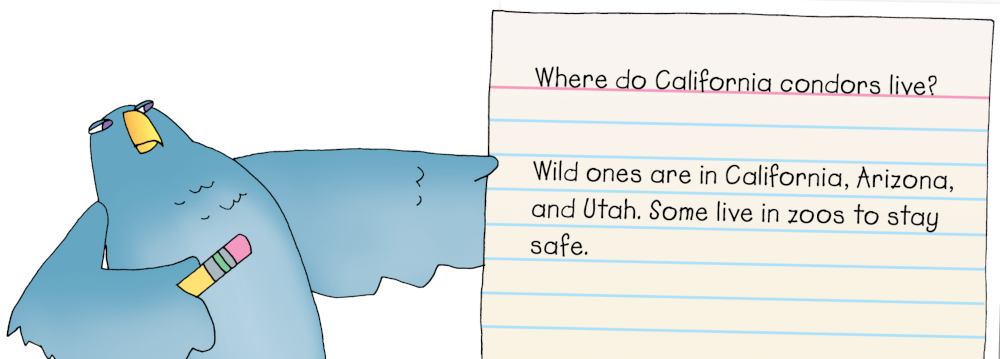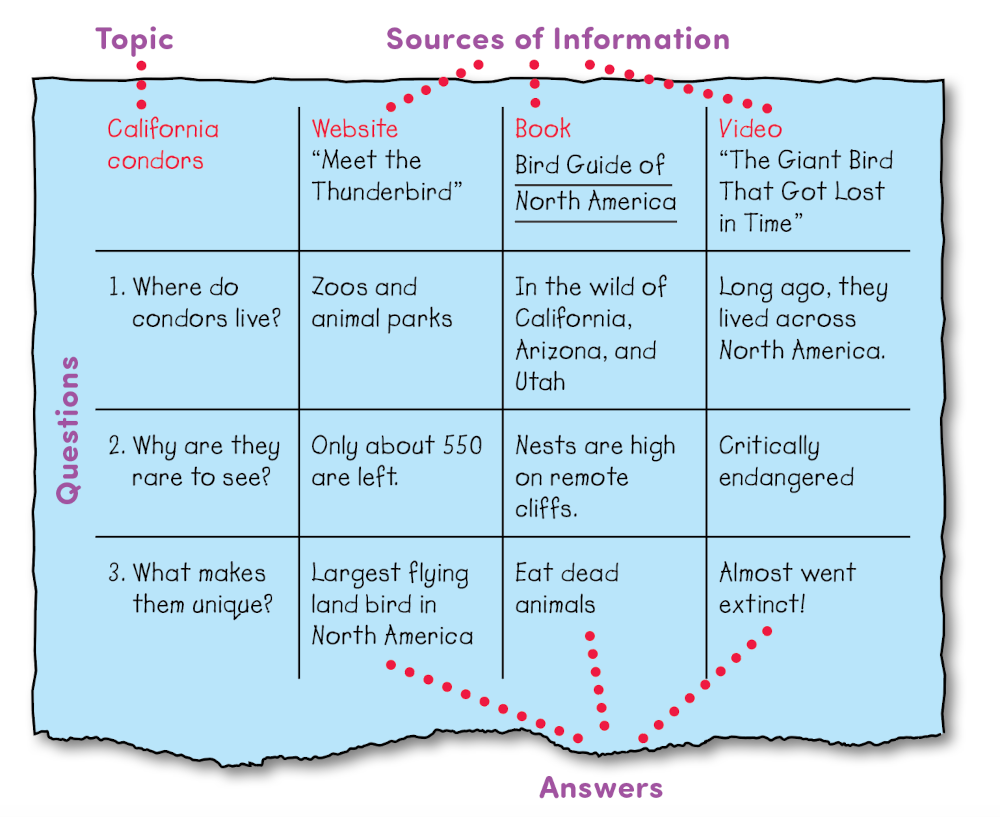WT 159
Page 159
Writing Classroom Reports
Our world is full of amazing things: snowflakes, fireflies, mountains, whales, tadpoles, comets. You can learn about any topic that interests you and share what you learned in a classroom report. Your goal is to shine a light on one part of our amazing world.
Getting Started
At a zoo, Andy Levin saw a baby California condor that would later grow into a huge bird. He studied more about these scavengers and wrote a report. This chapter will show you the steps he took to create a good classroom report. You can follow them, too!

WT 160
Page 160
Writing a Report
Prewriting
Choose a Good Topic 🟪 Pick a specific topic you would like to learn about.
🟪 If you’ve been assigned a general subject like birds, make a list of your specific favorites.
🟪 Look for more topic ideas in books, in magazines, or on the Internet. Also ask your friends or family members for ideas.
🟪 Think about each possible topic on your list. Choose the best one for your report.
🟪 Look for more topic ideas in books, in magazines, or on the Internet. Also ask your friends or family members for ideas.
🟪 Think about each possible topic on your list. Choose the best one for your report.
Write Questions About Your Topic 🟪 Think of questions that can’t be answered with a yes or a no. If your topic were condors, you might ask, “What does a condor eat?” or “Why are they rare to see?”
Tip
Record your questions in a notebook or on a computer document. Make sure to leave enough space for answers. You could also copy your questions on a gathering grid. (See page 162 for a sample grid.)
WT 161
Page 161
Learn About Your Topic 🟪 Use two or more different sources. Andy learned about California condors from a website, a book, and a video. Here are some common sources you can use to learn about your topic:

Answer Your Questions as You Learn 🟪 Write your answers in your notebook, document, or gathering grid. When you find important information, write down only the main ideas.
If a website says . . .

You can write . . .

WT 162
Page 162
Gathering Grid
A gathering grid helps you organize the information you collect about your topic.
Tips for Making a Gathering Grid
🟪 For computer grids, use a table or spreadsheet.
🟪 For handwritten grids, use a big piece of paper.
🟪 Draw lines to form a grid.
🟪 Write your topic, questions, and sources.
🟪 Fill in answers as you find them.
 © Thoughtful Learning 2025
© Thoughtful Learning 2025
🟪 For computer grids, use a table or spreadsheet.
🟪 For handwritten grids, use a big piece of paper.
🟪 Draw lines to form a grid.
🟪 Write your topic, questions, and sources.
🟪 Fill in answers as you find them.

WT 163
Page 163
Writing a Draft
Write the Beginning 🟪 Your first paragraph should tell what your report is about and capture the readers’ interest. Andy uses surprising details to hook his readers:
The largest flying bird in North America is also one of the rarest. That is actually good news. Not too long ago, California condors were almost lost forever.
Here are other ways Andy could have begun his report.
🟪 Start with a question:
Did you know that California condors can glide for miles without flapping once?
🟪 Share an interesting story:
Zoos saved condors from extinction.
Write the Middle 🟪 Write the main part of your report. The answers to a specific question belong together in the same paragraph. For example, Andy used one paragraph to report where California condors live.
Write the Ending 🟪 Make your ending strong. Tell what you have learned or how you feel about your topic. Andy wrote his last paragraph in this way:
California condors are back, but they are still in danger. We need new ways to protect these rare giants.
WT 164
Page 164
Revising
Read and Review 🟪 The questions listed below will help you review your first draft. (Also have a friend or classmate review your work.)
🟪 Did you include a beginning, a middle, and an ending?
🟪 Is each middle paragraph about one idea? (Does it answer one main question?)
🟪 Are there any parts that sound unclear or that need more information?
🟪 Is each middle paragraph about one idea? (Does it answer one main question?)
🟪 Are there any parts that sound unclear or that need more information?
Editing & Proofreading
Check for Errors 🟪 Check the spelling of all names and important terms. Make sure that all of your sentences begin with a capital letter and end with the correct punctuation mark.
Plan Your Final Copy 🟪 Are you going to add pictures or charts to your report? Are you going to make a cover for it? Be sure to check with your teacher. You may be asked to write or design your final copy in a certain way.
WT 165
Page 165
Sample Classroom Report
A Comeback Story
by Andy Levin
Beginning The largest flying bird in North America is also one of the rarest. That is actually good news. Not too long ago, California condors were almost lost forever.
Middle California condors are huge vultures. National Geographic for Kids says a California condor’s wingspan can reach 9 feet long. They can ride the wind and glide for hours without flapping once.
As they glide, they look for food. What do they eat? Dead animals! Condors are scavengers.
California condors remain critically endangered. In 2023, the population was about 550. In the 1980s, the species almost went extinct. The population dropped all the way to 22. That’s less than the number of students in our class!
To save the species, wildlife experts caught the remaining wild condors and brought them to zoos for protection. After years of careful breeding, some were released back into the wild. Now California condors fly freely in high, rocky areas of California, Arizona and Utah.
Ending California condors are back, but they are still in danger. We need new ways to protect these rare giants.
 © Thoughtful Learning 2025
© Thoughtful Learning 2025
A Comeback Story
by Andy Levin
Beginning The largest flying bird in North America is also one of the rarest. That is actually good news. Not too long ago, California condors were almost lost forever.
Middle California condors are huge vultures. National Geographic for Kids says a California condor’s wingspan can reach 9 feet long. They can ride the wind and glide for hours without flapping once.
As they glide, they look for food. What do they eat? Dead animals! Condors are scavengers.
California condors remain critically endangered. In 2023, the population was about 550. In the 1980s, the species almost went extinct. The population dropped all the way to 22. That’s less than the number of students in our class!
To save the species, wildlife experts caught the remaining wild condors and brought them to zoos for protection. After years of careful breeding, some were released back into the wild. Now California condors fly freely in high, rocky areas of California, Arizona and Utah.
Ending California condors are back, but they are still in danger. We need new ways to protect these rare giants.

Teacher Support:
Click to find out more about this resource.
© 2025 Thoughtful Learning. Copying is permitted.
k12.thoughtfullearning.com